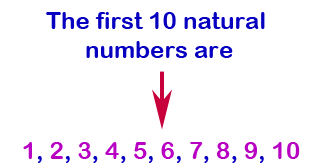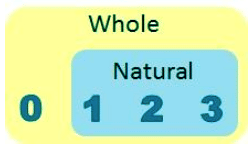Whole Numbers Class 6 Notes Maths Chapter 2
| Table of contents |

|
| Whole Numbers |

|
| Number Line |

|
| Addition on the Number Line |

|
| Subtraction on the Number Line |

|
| Multiplication on the Number Line |

|
Natural Numbers
All the positive counting numbers starting from one are called Natural Numbers.

Whole Numbers
Whole numbers are the collection of natural numbers including zero. So, the zero is the predecessor of 1 in the whole numbers.
Predecessor and Successor
If we add 1 to any natural number, we get the next number, which is called the Successor of that number.
For Example:
12 + 1 = 13
So 13 is the successor of 12.
If we subtract 1 from any natural number, we get the predecessor of that number.
For Example:
12 – 1 = 11
So 11 is the predecessor of 12.
Number Line
To draw a number line, follow these steps-
- Draw a line and mark a point 0 on it.
- Now mark the second point to the right of zero and label it as 1.
- The distance between the 0 and 1 is called the unit distance.
- Now you can mark other points as 2, 3, 4 and so on with the unit distance.

This is the number line for the whole numbers.
- The distance between two points
The distance between 3 and 5 is 2 units. Likewise, the distance between 1 and 6 is 5 units. - The greater number on the number line
The number on the right is always greater than the number on the left.
As number 5 is on the right of the number 2, Hence 5>2. - A smaller number on the number line
The number on the left of any number is always smaller than that number.
As number 3 is on the left of 7, so 3 < 7.
Addition on the Number Line
If we have to add 2 and 5, then start with 2 and make 5 jumps to the right. As our 5th jump is at 7 so the answer is 7. The sum of 2 and 5 is 2 + 5 = 7
The sum of 2 and 5 is 2 + 5 = 7
Subtraction on the Number Line
If we have to subtract 6 from 10, then we have to start from 10 and make 6 jumps to the left. As our 6th jump is at 4, so the answer is 4.
The subtraction of 6 from 10 is 10 – 6 = 4.
Multiplication on the Number Line
If we have to multiply 4 and 3, then Start from 0, make 4 jumps using 3 units at a time to the right, as you reach to 12. So, we say, 3 × 4 = 12.
|
153 docs|12 tests
|
FAQs on Whole Numbers Class 6 Notes Maths Chapter 2
| 1. What are natural numbers? |  |
| 2. What are whole numbers? |  |
| 3. What is the predecessor and successor of a number? |  |
| 4. How can a number line be used for addition? |  |
| 5. How can a number line be used for subtraction? |  |















